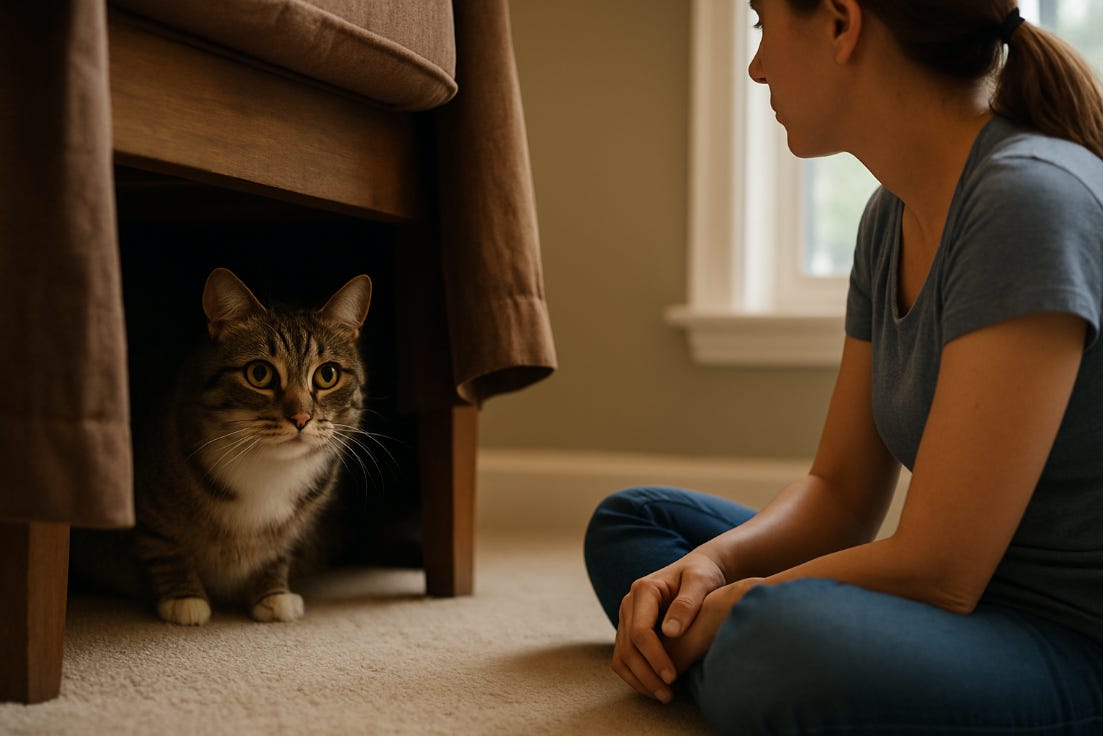Ask Me Anything #11: Struggling to Socialize a Feral Cat—Did I Do the Right Thing?
Rescuing Isn’t Always Easy—But It’s Always Worth Asking: What’s Best for the Cat?
When Rescue Feels Like Captivity
Not every rescue story unfolds with purrs and cuddles. In this Q&A, a devoted cat lover wrestles with guilt and uncertainty after taking in a feral cat who just won’t warm up. Can time and care heal old wounds—or are some cats simply wired to live on their own terms?
The Question
I’m struggling to socialize a feral/stray cat and starting to wonder if I made the right choice. He seems unhappy.
Background:
A cat appeared at my home on a 5-acre wooded lot. I fed him daily for 3 years, though he never let me touch him. When we moved, no shelters or neighbors could help, so I trapped him and took him to the vet. He was already neutered and microchipped to a small rescue that had lost track of him. They said I could keep him.
He spent a week in a room at our old house, then moved with us across state lines. He’s now in a quiet room with windows, hiding spots, litter, food, water, a cat tree, and a playpen. I tried the Socialization Saves Lives program, but he ignores treats and toys, and didn’t get any exercise confined to the playpen—so I let him out. He’s been in this room for two months. I visit twice daily; my husband joins occasionally. Still no progress.
We recently replaced the door with a screen so he can see our other pets (3 dogs, 1 cat). So far, very little interaction.
We’re moving again soon, and it’s been a lot—for him and for us. Some friends suggest he may never want to live indoors, and that may be true. But I couldn't leave him behind, and he wouldn’t be safe outside here.
I just want to know: Will he ever come around? Or am I doing something wrong?
Thanks,
T.T.
Animal Politics Responds
Hi T.T.,
First, let’s acknowledge something important: your compassion saved this cat’s life. You saw a vulnerable animal, took responsibility, and followed through with extraordinary effort—even when it got hard. That matters.
That said, your questions deserve honest, nuanced answers—because yes, some cats never fully socialize, and yes, you might feel like you’ve “imprisoned” a creature who wants something you can’t safely give. But that doesn’t mean you did the wrong thing.
Here’s what your story reveals:
1. You’re not doing anything wrong. You’re doing everything right—just with a very hard case.
Three years of avoiding contact outdoors, disinterest in treats, toys, and minimal social progress all suggest you’re dealing with a truly feral or extremely undersocialized cat. These cats often never adjust fully to indoor, human-centered lives. That doesn’t mean they can’t adapt—but their version of “success” might look different.
For some, it’s a quiet room, predictable routines, and minimal interaction. Think of it as a sanctuary life—not a failure, but a humane compromise.
2. His quality of life isn’t determined by affection—it’s about safety, stability, and choice.
You’ve provided a soft landing: shelter, food, peace, and protection. His hiding, watching, and quietness aren’t necessarily signs of misery. For some ferals, not being terrified is progress. Is he eating? Using the litter box? Grooming? If so, he’s not suffering—he’s coping.
3. Socialization isn’t linear, and some cats simply plateau. That’s okay.
The “Socialization Saves Lives” model is helpful for many, but it’s not one-size-fits-all. If food and play drive aren’t there, you’re left with presence and patience. Think of yourself as a constant, non-threatening background character. Sit and read aloud. Nap in the room. Let time work on its own terms.
4. The question isn’t whether you made him happy—it’s whether you made him safer. You did.
Releasing him in a new town is not ethical or safe. His territory, known hiding spots, and resources are gone. Outdoors now is not the same as outdoors before. Even if he’s not “happy” in the way we define it, he’s not starving, freezing, fighting, or dying alone.
5. Long-term options to consider:
Lifetime sanctuary room: He might thrive best with a stable, low-stimulus indoor setup.
“Porch cat” compromise: If your final home allows it, a secured catio or enclosed outdoor access might give him enrichment and autonomy.
Long-haul patience: You may find that six months, a year, even two down the line, he begins to soften. Some do—when they realize they’re finally safe.
Final thought:
You didn’t rescue him for affection. You rescued him for protection.
You’ve done that.
And sometimes, the kindest thing we can do for a wild-hearted animal is not ask them to become someone they’re not, but give them a life where they don’t have to be afraid.
You’re not failing him. You’re honoring him.
—Ed
Have You Faced This Too?
I suspect many of you reading this have opened your hearts and homes to feral or semi-feral cats. Have you ever faced a situation like T.T.’s—where your compassion met a wall of feline resistance?
What helped? What didn’t? What do you wish you’d known then that you know now?
T.T. (and I) would love to hear from others who’ve walked this difficult, uncertain road. Share your insights in the comments—we’re listening.
Ed Boks is a former Executive Director of the New York City, City of Los Angeles, and Maricopa County Animal Care & Control Departments, and a former Board Director of the National Animal Control Association. His work has been published in the LA Times, New York Times, Newsweek, Real Clear Policy, Sentient Media, and now on Animal Politics with Ed Boks.
Stay Informed
For more analysis and updates on the evolving landscape of animal welfare policy, visit Animal Politics with Ed Boks.






TT--I was in a similar situation as you, and I too grappled with questions of ethics and not knowing what was best for the cat. There was an unfixed cat roaming my town, with people expressing concern about his poor condition. He roamed a large area and was very hard to trap, but I did it. He was unfixed and had a large ulceration on his nose. He was estimated to be 7 years old. He was unsocialized, aggressive, and large. My original plan to TNR him and return him to his neighborhood didn't work out because I had the ulceration biopsied and it was squamous cell carcinoma. I knew I could not put him back out there to suffer and die, and I lived too far away to allow him to remain in his old territory outside. So we converted our garage to his home and built a catio off it so he could be outdoors when he wanted. We got him cancer treatments that were practical for his situation (that's a story in itself considering he would not allow any touch), but nothing worked, and he was eventually on pain meds. We too used Socialization Saves Lives methods, but it was a challenging effort. He lived 15 months with us, and he was not as afraid or aggressive over time, but I never could touch him and he always hissed at me. We developed a bond of sorts nonetheless (and my other cat wanted nothing to do with him). The cancer overcame him and he was euthanized in his catio with me by his side, and in death I touched him for the first and only time. (Finding a vet who could euthanize an unsocialized cat was very difficult but I found a savvy vet and we made a plan ahead of time of how it would go and we enacted the plan when the time came.) He was a very special cat. Thank you for helping your cat, I totally understand the situation you are in.
Hi Ed - thanks for addressing this issue. I currently have two cats - one is feral – I called her Sophie Ann (second name from the person who rescued her.) Four years ago, on June 14th, I took her into my home. She has never let me touch her, and I realize it is a process and will take the time it takes. A friend who lives in a residential town, north of NYC, was feeding a few ferals. She trapped one of them, who appeared to be ill. She took her to the vet and learned she had pyometra, which spaying cured. Poor Sophie must have given birth to many litters of kittens whose whereabouts are unknown.
I had recently lost my Tabitha and said I would take this cat. Having rescued semi-ferals before, I knew what to expect. The story was that she had been thrown out of her home when her people moved away some years before, when she was still a kitten. At the time I took her, she was estimated to be about four or five.
Sophie is very timid. She will still not allow me to touch her and backs away – sometimes hissing. But she seems comfortable here – has her favorite hut, chair, and loves my bed. She can sit anywhere she wants. Dorsey, my male cat who is about two years older, wants desperately to play with her, but she will have none of it. Yet, I see them hanging around together.
I am at the point where I can give Sophie Churus /Delectables. I used to put it on a small spatula, but she now will lick it off my finger. (I don’t think she realizes that it is attached to me) That’s a huge improvement. Cats love this treat. Many rescuers use it to socialize feral kittens. Another thing I’ve done is to attach feathers to a long pole (from a cat toy). She will engage in playing with me when I use this toy. This was progress since she had not been interested in toys - or catnip. Part of it has short and fuzzy feathers, which I use to gently touch her forehead and back. It must feel so good and non-threatening that she allows me to do it. I will continue doing this with her, hoping she will someday allow me to pet her. Sometimes I have seen her lying on top of my clothes on the bed. I think that an article of clothing with your scent is a good thing for feral cats since it allows them to get to know you better, but on their terms.
At the beginning, I would say to my friend who rescued her that I wondered if it would have been better if she had been returned outside - that she seemed so unhappy. But she disagreed. She is fed and lives in a comfortable environment and has a cat friend in Dorsey. When she was at the vet 4 years ago, I asked about her teeth and was told they were fine - all four of them. Sophie probably broke them while chewing bones from birds and small mammals she killed to survive. She has a home with me for as long as she lives. BTW - she is the calico in the small picture next to my name.
I hope this is helpful to anyone who thinks to take in an older feral. I don’t regret it and realize that her socialization will take the time it takes – I accept the slow progress and know she is much better off than being outside.